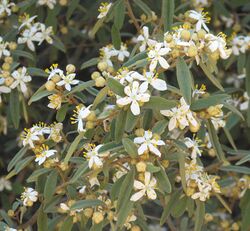Biology:Asterolasia hexapetala
| Asterolasia hexapetala | |
|---|---|

| |
| In Maranoa Gardens | |
| Scientific classification | |
| Kingdom: | Plantae |
| Clade: | Tracheophytes |
| Clade: | Angiosperms |
| Clade: | Eudicots |
| Clade: | Rosids |
| Order: | Sapindales |
| Family: | Rutaceae |
| Genus: | Asterolasia |
| Species: | A. hexapetala
|
| Binomial name | |
| Asterolasia hexapetala (Juss.) Druce[1]
| |
| Synonyms[1] | |
| |
Asterolasia hexapetala is a species of erect, spreading shrub that is endemic to the Warrumbungles in New South Wales. It has oblong to elliptical leaves with star-shaped hairs, especially on the lower surface, and white flowers arranged in small groups in leaf axils and on the ends of branchlets, the back of the petals densely covered with white, yellow or brown, woolly star-shaped hairs.
Description
Asterolasia hexapetala is an erect, spreading shrub that typically grows to a height of 3 m (9.8 ft). The leaves are oblong to elliptical, 30–60 mm (1.2–2.4 in) long and 5–15 mm (0.20–0.59 in) wide on a petiole 5–15 mm (0.20–0.59 in) long. The leaves are covered with white to brownish, woolly, star-shaped hairs, usually paler and more densely covered on the lower surface. The flowers are arranged in small umbels in leaf axils and on the ends of branchlets, each flower on a pedicel 5–20 mm (0.20–0.79 in) long. The five petals are white to yellow, mostly 7–9 mm (0.28–0.35 in) long, densely covered with white to yellow or brown, woolly, star-shaped hairs on the back. Flowering occurs in spring.[2][3][4]
Taxonomy
This species was first formally described in 1825 by French botanist Antoine Laurent de Jussieu, who gave it the name Phebalium hexapetalum.[5][6] In 1917, George Claridge Druce changed the name to Asterolasia hexapetala.[7] The name originates from the Ancient Greek words; aster, lasios, and hexapetala, meaning star, hairy (referring to hairs on the leaves), and six-petals.
Distribution and habitat
This asterolasia is only found in the Warrumbungle Ranges where it mainly grows along watercourses in forest and woodland.[2][3]
Use in horticulture
Asterolasoa hexapetala prefers a moist, well drained and lightly shaded situation. Established plants are able to cope with dry periods. Plants may be propagated by cuttings or from seed, with some difficulty.[4]
References
- ↑ 1.0 1.1 "Asterolasia hexapetala". Australian Plant Census. https://biodiversity.org.au/nsl/services/apc-format/display/108175. Retrieved 8 July 2020.
- ↑ 2.0 2.1 "Asterolasia hexapetala". Royal Botanic Garden Sydney. http://plantnet.rbgsyd.nsw.gov.au/cgi-bin/NSWfl.pl?page=nswfl&lvl=sp&name=Asterolasia~hexapetala. Retrieved 8 July 2020.
- ↑ 3.0 3.1 Wilson, Paul G.. "Asterolasia hexapetala". Australian Biological Resources Study, Department of Agriculture, Water and the Environment, Canberra. https://profiles.ala.org.au/opus/foa/profile/Asterolasia%20hexapetala. Retrieved 8 July 2020.
- ↑ 4.0 4.1 "Asterolasia hexapetala". Australian Native Plants Society (Australia). https://anpsa.org.au/plant_profiles/asterolasia-hexapetala/.
- ↑ "Phebalium hexapetalum". APNI. https://id.biodiversity.org.au/instance/apni/499266. Retrieved 8 July 2020.
- ↑ de Jussieu, Adrien-Henri (1825). "Monographie du genre Phebalium.". Mémoires de la Société d'Histoire Naturelle de Paris 2: 131–132. https://www.biodiversitylibrary.org/item/23524#page/143/mode/1up. Retrieved 8 July 2020.
- ↑ "Asterolasia hexapetala". APNI. https://id.biodiversity.org.au/instance/apni/538880. Retrieved 8 July 2020.
Wikidata ☰ Q4810769 entry
 |


